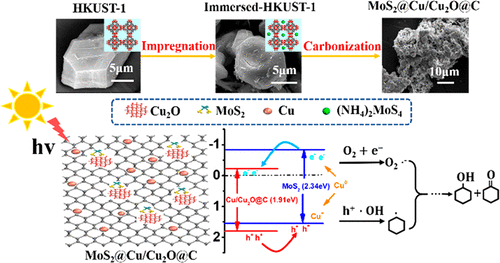当前位置:
X-MOL 学术
›
ACS Sustain. Chem. Eng.
›
论文详情
Our official English website, www.x-mol.net, welcomes your feedback! (Note: you will need to create a separate account there.)
Synthesis of Multilevel Structured MoS2@Cu/Cu2O@C Visible-Light-Driven Photocatalyst Derived from MOF–Guest Polyhedra for Cyclohexane Oxidation
ACS Sustainable Chemistry & Engineering ( IF 8.4 ) Pub Date : 2020-04-08 , DOI: 10.1021/acssuschemeng.9b07212 Dandan Peng 1, 2 , Ying Zhang 1, 2 , Guang Xu 1 , Ye Tian 1 , Di Ma 1 , Yao Zhang 1 , Ping Qiu 1
ACS Sustainable Chemistry & Engineering ( IF 8.4 ) Pub Date : 2020-04-08 , DOI: 10.1021/acssuschemeng.9b07212 Dandan Peng 1, 2 , Ying Zhang 1, 2 , Guang Xu 1 , Ye Tian 1 , Di Ma 1 , Yao Zhang 1 , Ping Qiu 1
Affiliation

|
Selective oxidation of cyclohexane to KA oil (cyclohexanol and cyclohexanone) is one of the most important industrial procedure. In this study, we reported a remarkably enhanced cyclohexane oxidation under visible-light irradiation by a novel MoS2@Cu/Cu2O@C composite photocatalyst with multilevel hierarchy, which was prepared by immersing (NH4)2MoS4 guest into Cu-metal–organic framework (MOF) polyhedra host and subsequently pyrolyzing the Cu-MOF–guest polyhedra to encapsulate MoS2 into Cu/Cu2O@C. Importantly, the composite photocatalyst showed much better photocatalytic cyclohexane oxidation performance than that of the simple mechanical mixture of MoS2 and Cu/Cu2O@C. The distinct photocatalytic performance of MoS2@Cu/Cu2O@C composite can be ascribed to its heterojunction band reconstruction and unique multilevel architecture to facilitate the separation of photoinduced electrons and holes and generation reactive species during photoirradiation. The Cu nanoparticles in the MoS2@Cu/Cu2O@C composite also effectively capture electrons and prevent electron–hole recombination due to the surface plasmon resonance (SPR). The photogenerated holes (h+) and ·OH radical were supposed to be predominant components of the valence band (VB) and oxidize cyclohexane (C6H12) to produce cyclohexyl radical (C6H11·), which can be further oxidized to cyclohexanol and cyclohexanone. According to the above results, a possible photocatalytic mechanism was proposed.
中文翻译:

MOF-Guest多面体衍生的多级结构MoS 2 @ Cu / Cu 2 O @ C可见光驱动光催化剂的合成用于环己烷氧化
将环己烷选择性氧化为KA油(环己醇和环己酮)是最重要的工业程序之一。在这项研究中,我们报道了通过将(NH 4)2 MoS 4客体浸入Cu中制备的新型多级MoS 2 @ Cu / Cu 2 O @ C复合光催化剂在可见光照射下环己烷氧化显着增强。-金属-有机骨架(MOF)多面体宿主,然后热解Cu-MOF-客体多面体,将MoS 2封装到Cu / Cu 2 O @ C中。重要的是,复合光催化剂显示出比简单的MoS机械混合物更好的光催化环己烷氧化性能2和Cu / Cu 2 O @ C。MoS 2 @ Cu / Cu 2 O @ C复合材料的独特光催化性能可以归因于其异质结带重建和独特的多级结构,以促进光致电子和空穴的分离以及在光辐照过程中产生反应性物种。MoS 2 @ Cu / Cu 2 O @ C复合材料中的Cu纳米颗粒还可以有效捕获电子,并防止由于表面等离振子共振(SPR)引起的电子-空穴复合。光生空穴(h +)和·OH自由基被认为是价带(VB)的主要成分,并氧化环己烷(C 6 H 12)生成环己基自由基(C 6 H 11 ·),可以将其进一步氧化为环己醇和环己酮。根据以上结果,提出了一种可能的光催化机理。
更新日期:2020-04-08
中文翻译:

MOF-Guest多面体衍生的多级结构MoS 2 @ Cu / Cu 2 O @ C可见光驱动光催化剂的合成用于环己烷氧化
将环己烷选择性氧化为KA油(环己醇和环己酮)是最重要的工业程序之一。在这项研究中,我们报道了通过将(NH 4)2 MoS 4客体浸入Cu中制备的新型多级MoS 2 @ Cu / Cu 2 O @ C复合光催化剂在可见光照射下环己烷氧化显着增强。-金属-有机骨架(MOF)多面体宿主,然后热解Cu-MOF-客体多面体,将MoS 2封装到Cu / Cu 2 O @ C中。重要的是,复合光催化剂显示出比简单的MoS机械混合物更好的光催化环己烷氧化性能2和Cu / Cu 2 O @ C。MoS 2 @ Cu / Cu 2 O @ C复合材料的独特光催化性能可以归因于其异质结带重建和独特的多级结构,以促进光致电子和空穴的分离以及在光辐照过程中产生反应性物种。MoS 2 @ Cu / Cu 2 O @ C复合材料中的Cu纳米颗粒还可以有效捕获电子,并防止由于表面等离振子共振(SPR)引起的电子-空穴复合。光生空穴(h +)和·OH自由基被认为是价带(VB)的主要成分,并氧化环己烷(C 6 H 12)生成环己基自由基(C 6 H 11 ·),可以将其进一步氧化为环己醇和环己酮。根据以上结果,提出了一种可能的光催化机理。



























 京公网安备 11010802027423号
京公网安备 11010802027423号